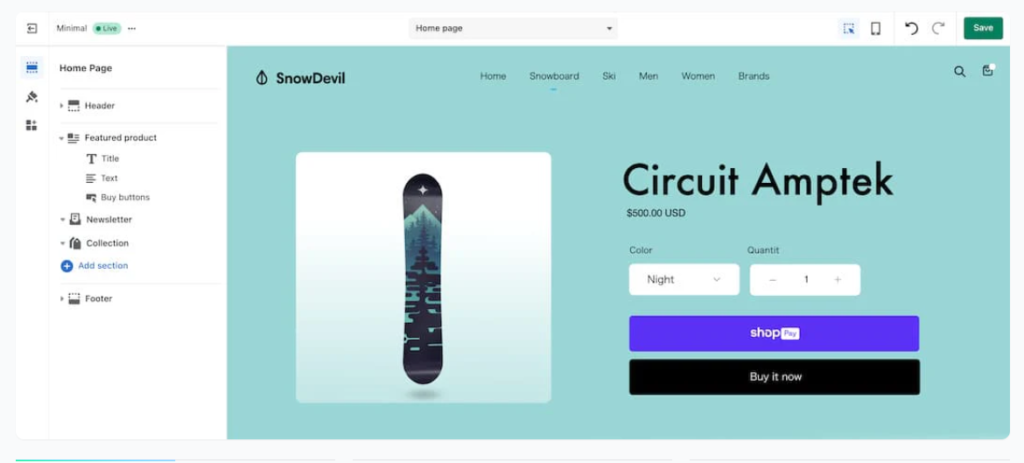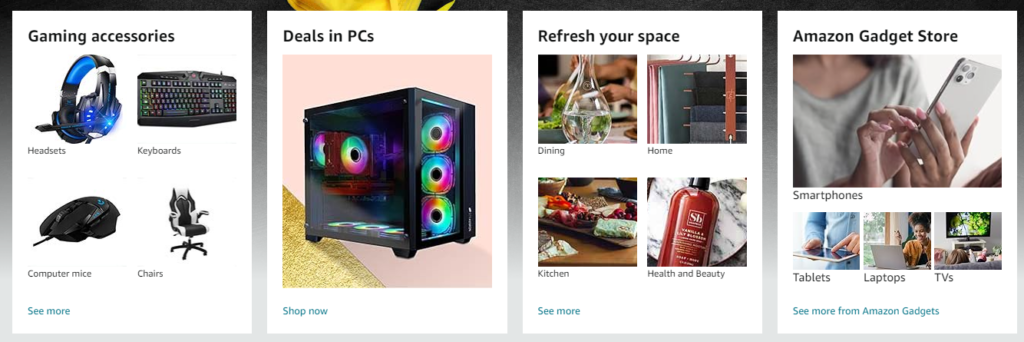In ecommerce, Shopify and Amazon stand out for anyone looking to sell online. But is Shopify the same as Amazon? At first glance, they serve a similar purpose, offering platforms for merchants to sell products.
However, a closer look shows that Shopify and Amazon cater to distinctly different aspects of the online selling experience.
In this article, we’ll compare Shopify and Amazon. We’ll explore their features, functionalities, and target audiences.
You’ll better understand which might fit your online business by the end.
Table of Contents
What is Shopify?
Shopify is an ecommerce platform that’s designed to help businesses—big and small—launch, manage, and grow their online stores.
It’s more than just a website builder; it’s a comprehensive solution that supports sales online and in-person with its retail point-of-sale systems.
One of Shopify’s standout features is its wide selection of customizable store designs. It doesn’t matter if you’re new to selling online or a seasoned designer—Shopify caters to all.

The platform allows you to start with a template and customize it to ensure your online presence reflects your brand.
Shopify’s wide range of features gives you many options to improve your store. It allows you to organize your products, add customer reviews, or create a loyalty program.
Also, Shopify knows how important marketing, sales, and social media are for any business.
It offers built-in search engine optimization (SEO), marketing, and social media integration tools.
These features are designed to help you not just attract visitors to your store but also engage and convert them into loyal customers.
What is Amazon?
Amazon started as an online bookstore and has grown into a large online platform where you can buy almost anything, from household items to electronics. It’s a place where, with a few clicks, you can order what you need and have it delivered to your home.
Beyond selling products, Amazon has expanded into other areas. It provides cloud computing services through Amazon Web Services, offers streaming entertainment with Amazon Prime Video, and has developed electronic devices like the Kindle for reading and Echo speakers that respond to voice commands.

One of the key reasons people shop on Amazon is because of its convenience. It offers quick ordering, fast delivery options, and an easy process for returning items if necessary.
Amazon Prime, a subscription service, gives members benefits like free shipping, special deals, and access to movies and TV shows.
Amazon also helps small businesses and individual sellers reach a broad audience by allowing them to sell their products on its platform.
With the Fulfillment by Amazon program, Amazon takes care of these sellers’ storage, packing, shipping, and customer service, making it easier for them to operate their businesses.
Critical Differences Between Shopify and Amazon
Shopify and Amazon are different platforms with unique appeal. Shopify is an online store toolkit, while Amazon is an online marketplace.
Shopify is a user-friendly platform that allows users to sell their goods online. Amazon is an online marketplace with millions of consumers.
Shopify is ideal for e-commerce entrepreneurs looking to develop their brands. Amazon is suitable for those who want to exploit the thriving Amazon marketplace.
Shopify gives users full ownership over their online store, including its branding, layout, and customer experience. Amazon sellers receive payments every two weeks. Shopify Payments payouts are usually available within three business days.
Shopify has transparent pricing, with no transaction fees when using the Shopify Payments gateway. Amazon Pay payment gateway accepts credit and debit cards, but extra fees are included.
Comparing Shopify and Amazon is like looking at two sides of the online selling world.
Both have unique strengths but cater to different business needs and strategies. Let’s break down the key differences.
Business model
Shopify is a platform that lets you build your online store from scratch. It’s like being given a plot of land and all the tools you need to make a house exactly how you want it.
You pay a monthly fee to use Shopify’s tools and services, but the store you create is entirely yours.
Conversely, Amazon is like a giant shopping mall where you can set up a shop.
You’re one of many stores under Amazon’s roof, which means you get to tap into their massive customer base, but you’re also competing directly with other sellers, including Amazon itself.
Control and branding
With Shopify, you can make your store look and feel exactly how you want. This control extends to the customer experience, allowing you to provide a unique shopping journey that can set you apart from competitors.
It’s your space to brand as you see fit so you can build a distinct identity in the marketplace.
Amazon provides less room for individual branding and control over the customer experience.
Your product pages must follow Amazon’s format, and the overall shopping experience feels very “Amazon” no matter what you’re buying.
This can make it harder to stand out and build a loyal customer base that recognizes and prefers your brand.
Fees and payments
Shopify charges a monthly subscription fee, depending on your chosen plan. Additionally, there are fees for payment processing and additional charges if you use payment providers outside Shopify Payments. However, you can select which services you use and how you want to expand your store’s functionality.
Amazon’s fee structure is different. There’s usually a per-item selling fee and a subscription fee if you’re a professional seller. Additionally, Amazon takes a cut of your sales, which varies by category.
While you benefit from access to Amazon’s vast audience, the fees can add up, especially for businesses with high sales volumes or low margins.
Traffic and visibility
Getting traffic to your Shopify store is up to you. You must invest in marketing, SEO, and social media to attract customers. It’s more work, but successful strategies can lead to a loyal following and direct traffic to your site without competing directly against others on the same platform.
Amazon already has a massive amount of traffic, which means millions can see your products of shoppers without much effort on your part. However, the challenge is standing out in a crowded marketplace.
You’ll need to master Amazon’s search algorithm, compete with other sellers on price and reviews, and possibly invest in Amazon’s advertising options to increase visibility.
Choosing between Shopify and Amazon comes down to what you want in an online selling experience.
Shopify offers more control and customization, ideal for building a brand and a direct customer relationship.
Amazon offers immediate access to a vast customer base and easier visibility but at the cost of higher competition and less control over branding and customer interactions.
Pros and cons
Navigating the world of online selling can be complex, and choosing the right platform is crucial.
Let’s explore the advantages and disadvantages of using Shopify and Amazon from a seller’s perspective and break down what makes each platform unique and what challenges you might face.
Shopify: Pros and Cons
Pros
- Customization and control. Shopify gives sellers unparalleled control over their store’s design, layout, and customer experience. This freedom allows for solid branding and a personalized shopping experience that can foster customer loyalty.
- Ecosystem and integrations. With an extensive app store, Shopify provides a wide array of tools and integrations for everything from marketing to inventory management. This allows sellers to tailor their store to their specific needs.
- Direct customer relationships. Selling on Shopify means you’re building a direct relationship with your customers. You can access customer data, which can be leveraged for marketing and building repeat business.
- Simple fee structure. Shopify’s subscription-based model offers transparent monthly and transaction fees, making understanding and managing costs easier.
Cons
- Customer acquisition. Unlike Amazon, driving traffic to a Shopify store is entirely up to the seller. This requires effort and investment in marketing and SEO to attract customers.
- Initial setup. Building a store from scratch can be daunting, especially for new sellers who need more technical skills. Although Shopify is user-friendly, there’s a learning curve to setting up and optimizing your store.
- Cost of apps. While Shopify’s core functionality is robust, many sellers need additional apps for specific features, which can add to the monthly cost.
Amazon: Pros and Cons
Pros
- Massive audience. Amazon’s vast customer base provides immediate visibility and access to millions of potential buyers, which can take years to build independently.
- Fulfillment by Amazon (FBA). Amazon’s FBA service takes the hassle out of storage, shipping, and customer service. It makes it easier for sellers to scale their business.
- Trust and credibility. Selling on a well-known platform like Amazon can lend credibility to your products, as customers trust Amazon’s customer service and return policies.
Cons
- Competition. The sheer number of sellers on Amazon means intense competition, often leading to a race to the bottom on prices and margins.
- Fees. Amazon’s fee structure can be complex and costly, with listing fees, selling fees, and FBA fees, which can significantly impact your bottom line.
- Limited branding. Your ability to brand and customize your product listings is limited on Amazon. You’re one of many sellers, which makes it harder to stand out and build a unique brand identity.
- Dependency. Relying on Amazon for sales can be risky. Policy changes, account suspensions, or shifts in the algorithm can dramatically affect your business overnight.
Read Also: Why Would Someone Use Shopify (Main Benefits)
Which Platform is Right for You?
Choosing between Shopify and Amazon depends on your specific business needs and goals.
Shopify is likely the better choice if you’re focused on building a strong, recognizable brand and value having direct customer relationships.
It offers excellent store design and marketing flexibility for long-term brand development and customer engagement.
However, Amazon might be more suitable if your priority is quickly reaching a broad audience without extensive marketing or brand building.
With its vast customer base and Fulfillment by Amazon (FBA) services, Amazon can help you start selling and managing logistics more easily. However, it comes with higher competition and less control over branding.
For unique or niche products, Shopify provides an opportunity to create a specialized shopping experience. Amazon’s visibility can give you an edge for everyday or highly competitive products.
Ultimately, your decision should align with your business model, the type of products you sell, your resources for marketing, and your goals for customer engagement and brand building.
Shopify offers more control and customization for a tailored brand presence, while Amazon provides convenience and immediate access to a large audience.
So, Is Shopify the Same as Amazon?
These two platforms are not the same; they are two sides of the ecommerce coin. Both offer unique advantages and cater to different needs within the online selling space.
By understanding the distinctions and aligning them with your business objectives, you can choose the one that best suits your online needs.
Frequently Asked Questions
1. Is Shopify the same as Amazon?
No, Shopify and Amazon are not the same. Shopify is a platform that allows businesses to create online stores and provides customization, marketing, and sales tools. Amazon is an online marketplace where companies can sell products alongside other sellers, tapping into Amazon’s vast customer base.
2. Can I use Shopify to sell on Amazon?
Yes, you can use Shopify to sell on Amazon. Shopify’s integration allows sellers to list their products on Amazon and manage their inventory directly from their Shopify dashboard. This makes it easier to reach Amazon’s audience while managing sales through Shopify.
3. Which is better for beginners, Shopify or Amazon?
For beginners, the choice between Shopify and Amazon depends on your goals and resources. Shopify might be the better option if you’re interested in building a brand and have the time to invest in marketing. Amazon could be more suitable if you’re looking for quick access to a large customer base and are okay with the competition.
4. Do I need inventory to sell on Shopify or Amazon?
You will generally need to manage your inventory or use a third-party fulfillment service for Shopify. Amazon offers the Fulfillment by Amazon (FBA) service, where you can send your products to Amazon’s fulfillment centers, and they will handle storage, shipping, and customer service for you.
5. Can I sell the same products on both Shopify and Amazon?
Yes, you can sell the same products on both Shopify and Amazon. Many businesses use both platforms to maximize their reach and sales potential. However, managing your inventory effectively across both platforms is vital to avoid stock issues.
6. How do Shopify and Amazon handle shipping?
Shopify allows sellers to manage their shipping or integrate with third-party logistics providers. Sellers can set their shipping rates and options. Amazon offers FBA, where Amazon handles shipping, or sellers can fulfill orders themselves under the Fulfillment by Merchant (FBM) option.
7. Can I build a brand on Amazon?
Building a brand on Amazon is possible through the Amazon Brand Registry, which offers tools to help protect your brand and create a more branded shopping experience. However, the ability to customize and control the brand experience is more limited on Amazon than on Shopify.

